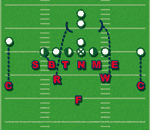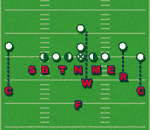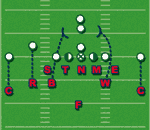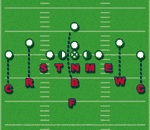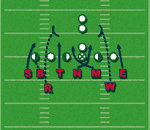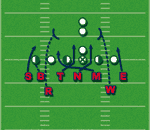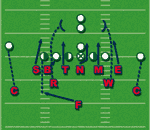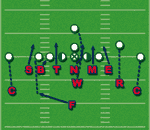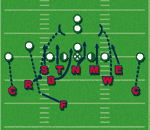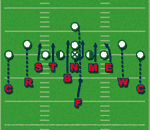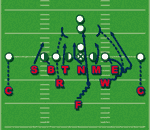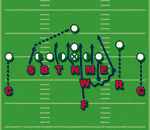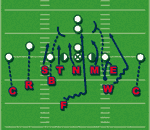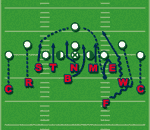AMERICAN FOOTBALL MONTHLY THE #1 RESOURCE FOR FOOTBALL COACHES
Article CategoriesAFM Magazine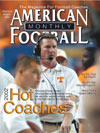
|
To Macho and Back with Stephen F. AustinMichael Adams (#90), a defensive end who was ranked among the tops in the country last year by The Sports Network, has moved to linebacker this season.by: Kim Dameron SFA Defensive Coordinator © More from this issue To start with I would like to thank American Football Monthly for providing coaches with valuable articles and ideas from some of the top coaches in the game. I am honored to submit this article and I hope it will live up to the standard of previous publications. The subject of this article “To Macho and Back with S.F.A.” is a brief overview of how we call, adjust and stem out of our Double Eagle or “Bear” package as well as some of the stunts and movements we deploy out of this front. The reason we call it Macho is because we mug up the Middle Backer in the weak B gap to get to this particular front. Getting in and out of Macho from an “Up G” or balanced eight man front has become a very effective part of our aggressive eight man front package here at Stephen F. Austin One of the biggest advantages to this package is that it takes the play calling out of the hands of an experienced Offensive Coordinator sitting high above the action and puts it in the hands of a less experienced Quarterback that is seeing things at eye level. My experience has been that when offenses see our Macho front they have a tendency to check out of base runs and into some from of speed option or quick pass. Therein lies the question, are we going to stay in Macho or possibly stem to a front that is better designed to handle those types of plays? As for me, I would rather play this game of Cat and Mouse with an 18-22 year old college quarterback than with a 40-50 year old coordinator, and this package allows me to do just that. The way we call the front is very simple and has the same rules for front alignment as every other front we call. Strength is always called to the Tight End or Passing Strength if no T.E. is in the formation. Balanced one back sets are called to the field with the ball on the hash or to the QB’s arm strength with the ball in the middle of the field. Players that go to the front call are the Tackle, Stud, Backer and the Rover. Players that go away from the call are the Nose, End, Mac and Whip. In the Macho front the Nose aligns in a Zero (Head up on the Center.) Alignments by Position: Stud - Cocked 9 Tech vs. T.E. / Cocked 5 Tech vs. no T.E. Tackle - Wide 3 Tech Nose - Zero Tech End - Cocked 5 Tech vs. no T.E. / Cocked 9 Tech vs. T.E. Backer - 7 Tech vs. T.E. / 50 Tech vs. no T.E. Mac - Wide 3 Tech with toes at heel depth of the Def. Line (Square Stance) Rover - 50 Tech vs. T.E. with 2 Backs / Adjust to Y vs. no T.E. with 2 Backs / Adjust to #2 Removed vs. 1 Back sets with T.E. / Adjust to Y vs. 1 Back sets with no T.E. Whip - 50 Tech vs. 2 Backs / Head up on remaining Back vs. 1 Back with a T.E. / 2nd Adjuster vs. 1 Back sets with no T.E. Assignments by Position: Stud - Cocked 9 or 5 Tech (Spill near back and all pullers / Contain Rush) Tackle - Wide 3 Tech Nose - Zero Tech (Center Killer, play of the back side of the centers block) End - Cocked 5 or 9 Tech (Spill near back and all pullers / Contain Rush) Backer - C Gap vs. Run. Man coverage on T.E. or 1st back strong if no T.E. Mac - B Gap vs. Run. B Gap Rush vs. Pass. Rover - Shoot support (Force) vs. Run To. A Gap Cutback vs. Run Away. Man Coverage on 1st Back Strong vs. 2 Backs with T.E. / Y vs. 2 Backs no T.E. / #2 removed vs. 1 Back with T.E. / Y vs. 1 Back no T.E. Whip - Shoot Support (Force) vs. Run To. A Gap Cutback vs. Run Away. Man Coverage on 1st Back Weak vs. 2 Backs. 2nd Adjuster vs. 1 Back with no T.E. 1. vs. Pro Set
2. vs. 1 Back
3. vs. 2 Backs no T.E.
4. vs. 1 Back no T.E.
Macho Stunts There are two base stunts that we use with the Macho front as well as the Mac playing the weak B gap. These stunts are called Axe and Blade. The names are a combination of the lst letter telling the Nose and Tackle which strong side gap the Mac is going to stunt into and also the relationship to our Lumberjack mascot. With both stunts the coverage is exactly the same as the base coverage. The technique of the Mac is critical to defending the weak side run game. The Mac aligns in a wide 3 Tech and focuses on the head and shoulders of the weak guard. If the guard pulls or pass sets the Mac executes his loop stunt into the strong side A or B gap depending on which stunt was called. If the guard reaches toward the Mac he must play the block of the guard and maintain weak B gap integrity (do not execute the stunt). If the guard reaches toward the nose the Mac will close down the weak B gap and anticipate a collision between the guard and the Nose in the weak A gap. When this collision occurs the Mac should work across the top of the Nose and become an extra defender to the strong side. In the case of a Blade stunt the Tackle will be stunting into the strong A gap and he can work across the top of both the Nose and the Tackle. Versus a weak side down-pull scheme the Mac should feel the angle of the down block. If the angle of the down block is deep (to his hip) and he is pinned, he should work through the B gap to escape then get flat down the line of scrimmage in pursuit. If the angle of the tackle is shallow (to his face) he should work across the face of the down block and fit inside the pulling guard. The technique of the Nose is a step stunt to the weak side A gap. This will always be executed away from the front call. This is a flat lateral step first, then the up the field to heel depth. His eyes should go the weak guard as he steps toward him and the play in his gap. The Tackles technique in a Blade stunt is the same as the Nose, except he is executing his stunt from an outside shaded alignment as opposed to being head up. The only difference comes when the strong guard reaches away from him. He should fill the strong A gap with the body of the guard and play off the backside of his block. 5. Macho Axe
6. Macho Blade
Macho Blitzes The blitz package from a Macho front is only limited by what you can teach, practice and execute. The two Blitzes we will go over in this article are Macho Backer and Macho Fox. Macho Backer is a Zero coverage blitz that can be used as a run stopper or a passing game pressure. The coverage for Macho Backer is an inside leverage man coverage. The Corners match on Z and X and the Free Safety comes from a deep middle alignment to cover the T.E. or Y position. The Rover and the Whip cover the two remaining backs. This gives us our five best coverage people on the offenses five eligible receivers. The only difference in alignment from a base call is when the Free Safety comes out of the middle of the field to cover the T.E. Assignments by position: Stud - Wide 9 Tech, contain rush / box force Tackle - 3 Tech, B Gap rush (do not come under the guard) Nose - Step to weak A Gap End - Wide 5 Tech, contain rush / box force Backer - Align in 7 Tech, step to and read the strong tackle on the snap. Vs. run block to or away, play run in the C gap. Vs. Pass set rush the strong A gap by looping behind the 3 Tech. Mac - Rush weak B Gap Rover - Use the same adjustment rules as other Macho calls. Whip - Use the same adjustment rules as other Macho calls. Free - Cover the Y position except vs. 4 WR’s. 7. Macho Backer vs. Pro Sets
8. Macho Backer vs. 1 Back
9. Macho Backer vs. 2 Backs no T.E.
10. Macho Backer vs. 1 Back no T.E.
Macho Fox is a little more aggressive style of blitz that is designed to be used against the pass more than the run. The Free Safety is used in this blitz as a rusher and the End is used as a coverage player. Assignments by Position: Stud - Wide 9 Tech, contain Rush, Train back vs. 1 Back sets. Tackle - Wide 3 Tech, B Gap rush (do not come under the guard) Nose - Step to strong A Gap End - Wide 5 Tech, Butt the tackle and cover 1st back weak Backer - 7 Tech vs. T.E., normal alignment adjustments vs. other formations. Man on T.E. vs. 2 Backs with a T.E./ Man on 1st back strong vs. 2 Backs with no T.E./ Man on T.E. vs. 1 Back with a T.E./ Blitz weak A gap vs. 1 Back with no T.E. Mac - Rush weak B Gap Rover - Use the same adjustments as other Macho calls. Whip - Show normal Macho alignment and walk out to weak D gap. Contain Rush Free Safety - Blitz weak A gap against all formations except 1 Back with no T.E. Cover #2 weak vs. doubles or #3 vs. Trips open. 11. Macho Fox vs. Pro Sets
12. Macho Fox vs. 1 Back
13. Macho Fox vs. 2 Backs no T.E.
14. Macho Fox vs. 1 Back no T.E.
Move G / Move Macho Move G is a call that aligns the defense in Macho front then, on the command of the Mac or the snap of the ball, the defense is moved to a G front with a 3 technique strong and a 21 weak. Move Macho is just the opposite. The defense aligns in a G front and moves into Macho. These two fronts work together because there are some plays that offenses don’t want to run into Macho such as base runs and counters and they normally check to some form of an option, sweep or quick pass. So we align in Macho to get them to change the play and when they do we move back to G and these plays are more easily defended. This also allows us to get a look at their plan against Macho without having to just line up and play. We also use Move Macho in the opposite direction. We can line up in a base G front that we play zone coverage out of and then move into Macho to stop some favorite runs. The move allows us to do this without letting the Q.B. know that he has man to man coverage on the outside and thus avoiding the quick passing game. Basic Defensive Philosophy The Defensive Philosophy we are committed to here at S.F.A. is to be an Aggressive Eight Man Front Attacking defense. We want our players to be able to line up and stop the run in our base package and also be sound and solid against the elaborate passing games we seek from week to week. We also want opposing offenses to know that we will blitz and/or pressure from anywhere on the field and against any personnel group. Combined with great team pursuit, we feel that this philosophy allows our players to cut loose and play at their highest level of performance. < |
|
| HOME |
MAGAZINE |
SUBSCRIBE | ONLINE COLUMNISTS | COACHING VIDEOS |
Copyright 2024, AmericanFootballMonthly.com
All Rights Reserved


